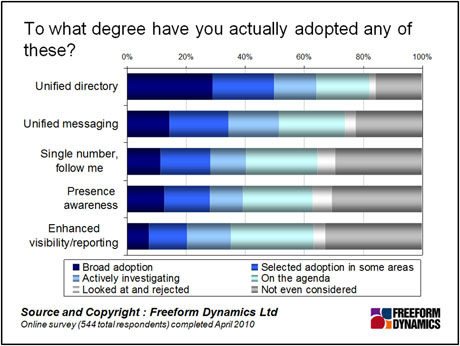Whether businesses like it or not, the likelihood is that unified communications (UC) in some form will insinuate itself into many workplaces at some point in the not-too-distant future.
Research carried out by Freeform Dynamics in April 2010 with 544 enterprises confirmed that UC is increasingly on the enterprise agenda in some shape or form. That fact is well illustrated in the chart below, which shows the extent to which enterprises have adopted, or are planning to adopt the different components of UC.

More businesses are recognising the benefits that UC can deliver, with improved collaboration, process streamlining and reduced travel costs, but implementing a system that actually delivers is not without problems.
A key concern is whether the benefits of UC will be achievable in practice, and if so, whether the benefits will outweigh the associated costs. Unfortunately, there is a lot of anecdotal evidence to support these concerns.
One of the main errors companies make is they expect UC to bring about change simply through its presence. The reason this won’t happen, and why UC implemented in this way is doomed to fail, is that it is a new system that delivers new capabilities, rather than something designed to fit the way people work in a non-UC context. When businesses fail to recognise and address this issue, things can start to go wrong.
In practice, to get UC to work properly requires companies to revisit how they do things currently, in a systematic and detailed way, and look at how they can be done differently to maximise the benefits of UC.
An example of this approach is the process of call-handling in a call centre. In a non-UC environment, agents will take calls and if they are unable to deal with the query, they will note down details and promise to ring the caller once they have the information they need.
They then contact the relevant experts on an iterative basis, until they have the required information. Only at this point can they go back to the caller. If the caller has a follow-on query, the whole process begins again. As well as affecting how the company is perceived by the caller, the process has to be carried out in a number of steps and is extremely time-consuming and resource-intensive.
In a UC environment, the process is essentially condensed. For the same call, the agent would try to resolve the call directly. At the point where other people need to be involved, the agent would identify which experts to deal with the query, determine their availability, contact experts in parallel, and connect with the most appropriate one to obtain a response to the query.
They would then either feedback the necessary information to the caller, or hand the call over to the expert to complete. And all this would appear seamless to the caller.
This example illustrates that UC brings with it the need to approach things differently. So if a company implements UC but does not significantly change its processes, the likelihood is that a few months down the line it will be closely questioning the investment and upheaval it has endured.
But changing the way things are done in terms of communications and processes in a company needs to be dealt with properly. Failure to provide the necessary support for this change, particularly in the early days, can ultimately lead to the failure of UC within the business.
Of course, part of this support is about ensuring IT staff are properly trained and have enough time allocated to deal with the uplift in helpdesk calls that are likely to follow implementation. But more importantly, businesses need to look beyond this, and consider the processes that people will need to follow to make the most of UC, and communicate them effectively throughout the business.
Moreover, this approach will need to be conducted in a specific and straightforward way. So, if someone wants to set up a videoconference meeting, what processes will they need to follow? What variants to these might exist, for example, involving home-based workers, or individuals from outside the company? And what is available in terms of help when things come unstuck?
The helpdesk is an obvious port of call but other options need to be made available, such as online resources, or even a nominated friendly face on the same floor or in the same department, who can help out with simple queries.
It makes sense to extend this approach to cover what people shouldn’t be doing with UC, and putting together a set of guidelines on good business etiquette. UC by its very nature makes people more available. But just because someone is available doesn’t mean they are open to constant interruption, particularly for trivial requests and queries.
Rather than looking at UC though rose-tinted spectacles and believing it will transform the workplace simply by its presence, it is vital to take the time to define exactly how UC will develop in the business, and how to make it easy for people to use.
Most staff will not be enthusiastic about UC. Many may not even know what it is, so the transition will need to overcome their natural resistance. The more they see it being used around the business – particularly by senior management – and the more best-practice guidance they are exposed to, the easier, and more importantly, the more successful the transition will be.
Content Contributors: Josie Sephton
Through our research and insights, we help bridge the gap between technology buyers and sellers.





Have You Read This?
From Barcode Scanning to Smart Data Capture
Beyond the Barcode: Smart Data Capture
The Evolving Role of Converged Infrastructure in Modern IT
Evaluating the Potential of Hyper-Converged Storage
Kubernetes as an enterprise multi-cloud enabler
A CX perspective on the Contact Centre
Automation of SAP Master Data Management
Tackling the software skills crunch